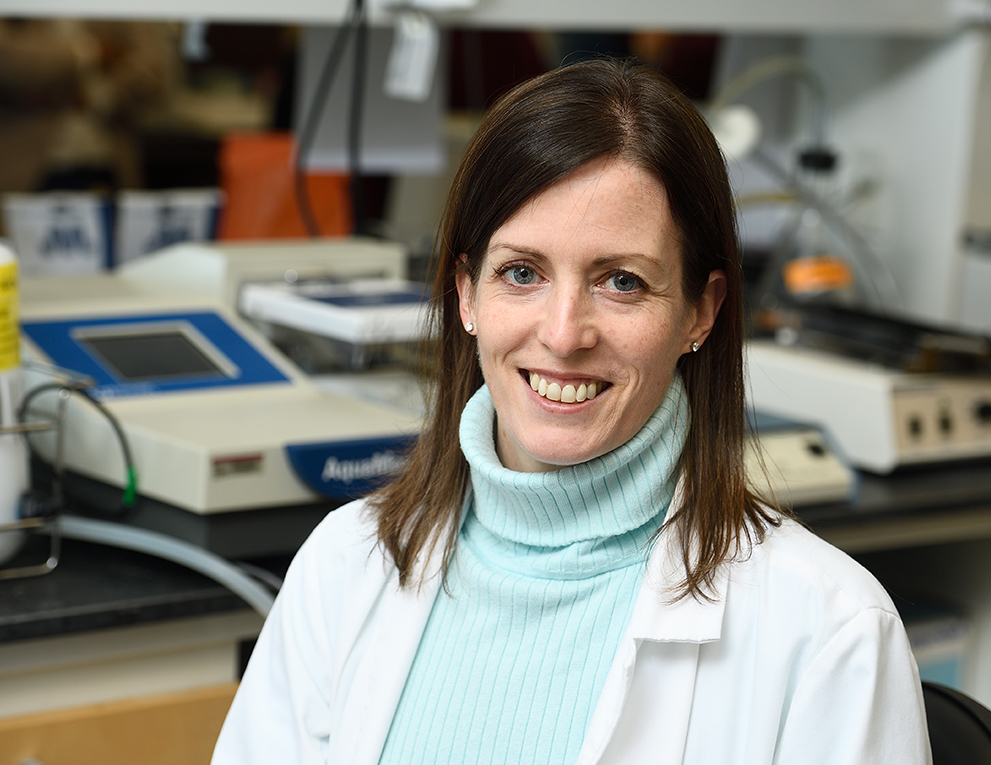Exploring Sex-Specific Features of HIV
Johns Hopkins researcher Eileen Scully advocates for including sex as a biological variable in preclinical and clinical trials that study the acquisition, progression and treatment of infectious diseases.

Eileen Scully is an associate professor in The Johns Hopkins University School of Medicine’s division of infectious diseases.
Early in her career, Johns Hopkins physician-scientist Eileen Scully began to explore ways that viral infections such as HIV, SARS-CoV-2 and tuberculosis manifest differently in individuals. One particular interest: the differences between biological males and females in how HIV is acquired and how it progresses.
“When HIV was first identified in the 1980s, only a handful of women were identified as having acquired the virus, ” says Scully, an associate professor in the Division of Infectious Diseases. “All of the early understanding of the disease, and the early testing of what we might be able to do, was done almost entirely in men.
“However, of the more than 39 million people in the world currently living with HIV, 51% are women or girls.“
She says studies have shown that HIV acquisition is affected by sex-based anatomical differences, mucosal microbiomes and gender-based health behaviors, and may also be impacted by sex-differential responses to preventive vaccines in development.
And she has become one of the nation’s strongest advocates for including sex as a biological variable in preclinical and clinical trials that examine the acquisition, progression and treatment of infectious diseases.
“We must ensure that sex-stratified results are clearly reported, using male and female animals in model systems,” she writes in Nature Microbiology. “We must also report the sex of the cells used for in vitro studies. And we must find ways to ethically recruit more cisgender and transgender women into clinical trials.”
Practicing at Hopkins since 2016, Scully treats patients who have HIV in the John G. Bartlett Specialty Practice, while her basic science lab runs interventional trials to bring her “bench to bedside” research to her patients. She also serves on the U.S. Department of Health and Human Services Panel on Antiretroviral Guidelines to assess treatment choices for HIV.
Some of her studies are looking into how the immune systems of males and females work differently.
Although protection against pathogens is a critical feature of the immune response, females have also evolved to to tolerate a genetically dissimilar fetus and transfer protective immunity through breast-feeding. Scully says this highlights how biological sex can shape the immune system.
“With that in mind, it makes sense that we wouldn’t have exactly the same programs for how we respond to pathogens, even though our overall goal of surviving the infection is the same,” she says.
In HIV there are multiple examples of how males and females have different responses. Females have lower viral loads in untreated disease, but progress to immune deficiency and AIDS at a similar rate. Females are also more likely to be among the rare individuals who can control HIV even without treatment. The reasons for these differences are not understood, but may provide important clues on how to interrupt HIV disease progression.
People who get effective HIV treatment can now live long, healthy lives and protect their partners. Current research is focused on curing the infection, which requires eliminating the HIV reservoir. The reservoir consists of immune cells that harbor a copy of the HIV genome but are not actively producing new HIV. Scully’s prior work suggests that the reservoir is different between males and females and that estrogen may directly impact the HIV reservoir. The data identifying estrogen as a regulator of HIV latency led Scully to design and lead a clinical trial through the Advancing Clinical Therapeutics Globally (ACTG) network to test the impact of estrogen receptor antagonism in combination with HIV latency reversal agents.
This study was the first cure trial designed only for women and dramatically increased the representation of women in HIV cure latency reversal trials. The team also conducted a social sciences survey among trial participants to understand why the women participated in the study and to help efforts for more inclusion of women in future trials.
Ongoing work is focused on identifying the mechanism for the effects of estrogen on HIV latency and exploring the impact of biological sex in other infections including SARS-CoV-2 and tuberculosis.
“I’m excited about this work because we start from clear clinical observations of differences and work towards the underlying pathways,” Scully says. “Exploring the sex specific features of immune responses will allow us to think about how we might tailor our treatment approaches to each individual and bring us closer to precision medicine.”
Related Reading
-
Johns Hopkins Physician Improves Standard of Care for Tuberculosis through Patient-centered Technology
Maunank Shah, an infectious diseases specialist, has developed mobile health tools now used nationally.

